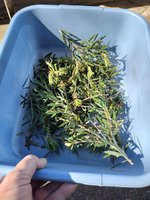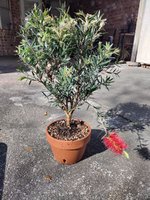I had to post my first go right?
Okay, so I bought a Callistemon. The only description was "Slim bottlebrush".
It came in a 3 gallon pot.
I chose this one as it ha a nice central trunk and fine, softer leaves and I don't think it is one of the larger growing varieties.
I chose a garden variety pot and to make it shallower, I placed an inverted 3" ashtray that was about 1 1/4" high.
I anchored it in place with pebbles that fit neatly around it and leveled it off with smaller quartz pebbles.
I then put in a thin 1/2" layer of decomposed granite and topped that off with another 1/2" layer of the final potting media - which consisted of pumice, perlite, decomposed granite and finely shredded compost.
I cut off about 8" of the root ball down to about 2 1/2" to fit to the top of the pot.
Then I tamped the media in around the roots firmish, then trimmed and watered. I will continue to trim but for now, I will just let it rest.
It drained beautifully.
As it stands right now, the total package is 22" tall.
Here's a couple of pics.

Okay, so I bought a Callistemon. The only description was "Slim bottlebrush".
It came in a 3 gallon pot.
I chose this one as it ha a nice central trunk and fine, softer leaves and I don't think it is one of the larger growing varieties.
I chose a garden variety pot and to make it shallower, I placed an inverted 3" ashtray that was about 1 1/4" high.
I anchored it in place with pebbles that fit neatly around it and leveled it off with smaller quartz pebbles.
I then put in a thin 1/2" layer of decomposed granite and topped that off with another 1/2" layer of the final potting media - which consisted of pumice, perlite, decomposed granite and finely shredded compost.
I cut off about 8" of the root ball down to about 2 1/2" to fit to the top of the pot.
Then I tamped the media in around the roots firmish, then trimmed and watered. I will continue to trim but for now, I will just let it rest.
It drained beautifully.
As it stands right now, the total package is 22" tall.
Here's a couple of pics.



